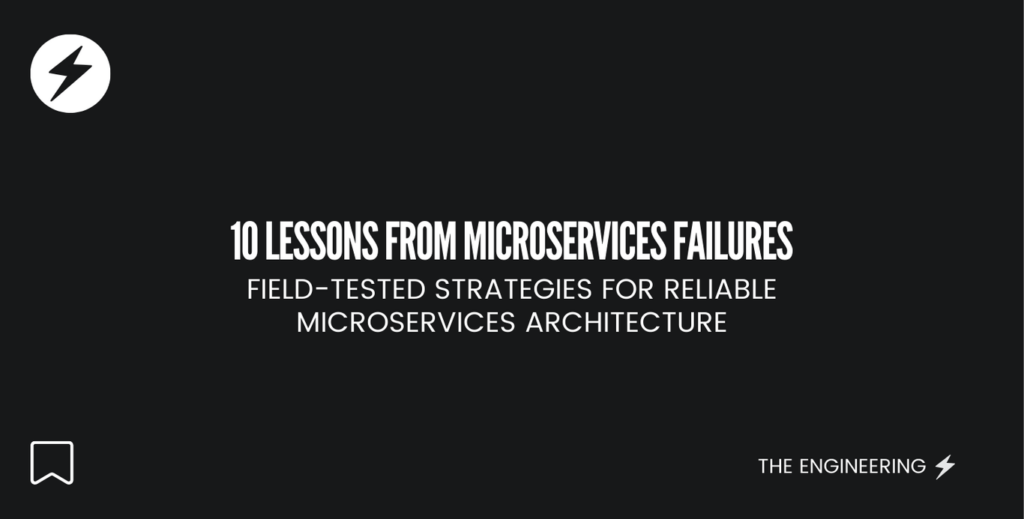
Microservices provide flexibility, scalability, and resilience, making them appealing for modern software development. However, adopting microservices can be challenging. Many organizations encounter significant pitfalls during implementation, resulting in failed projects, increased complexity, and inefficiencies. We will cover 10 microservices lessons from failures in real-world examples.
This article discusses ten important lessons learned from real-world microservices failures and provides actionable strategies to address these challenges. By recognizing these common pitfalls and implementing best practices, teams can develop a more robust, scalable, and maintainable microservices architecture that adds value for their users and businesses.
Lesson 1: The Shared Database Trap
The Pitfall
- Using a single database across multiple services
- Tight coupling between services
- Scalability bottlenecks
Best Practices
- Database per service pattern
- Data ownership boundaries
- Implementing eventual consistency
- Using event-driven patterns for data synchronization
Lesson 2: Deployment Hell
The Pitfall
- Manual deployment processes
- Lack of automation
- Inconsistent environments
Best Practices
- Implementing CI/CD pipelines
- Infrastructure as Code (IaC)
- Automated testing in a deployment pipeline
- Container orchestration (e.g., Kubernetes)
Lesson 3: Service Granularity Mistakes
The Pitfall
- Creating unnecessarily small services
- Focus on technical rather than business boundaries
- Over-decomposition
Best Practices
- Domain-Driven Design principles
- Bounded contexts
- Right-sizing services based on business capabilities
- Considering team structure and Conway’s Law
Lesson 4: Inadequate Monitoring and Observability
The Pitfall
- Lack of visibility into service behaviour
- Difficulty in debugging issues
- Poor performance tracking
Best Practices
- Implementing distributed tracing
- Centralized logging
- Metrics collection and alerting
- Service health monitoring
Lesson 5: Inter-Service Communication Chaos
The Pitfall
- Tight coupling through synchronous communication
- Cascading failures
- Network reliability issues
Best Practices
- Implementing circuit breakers
- Using asynchronous communication where appropriate
- API versioning strategies
- Service mesh implementation
Lesson 6: Testing Complexity
The Pitfall
- Over-reliance on end-to-end testing
- Difficult local development
- Slow feedback loops
Best Practices
- Comprehensive testing strategy (unit, integration, contract)
- Service virtualization
- Local development environments
- Test data management
Lesson 7: Security Oversights
The Pitfall
- Inconsistent security policies
- Exposed internal endpoints
- Poor authentication/authorization
Best Practices
- API gateway implementation
- Service-to-service authentication
- Secrets management
- Security monitoring and audit trails
Lesson 8: DevOps Culture Gap
The Pitfall
- Siloed teams
- Lack of ownership
- Poor collaboration
Best Practices
- Cross-functional teams
- DevOps practices adoption
- Shared responsibility model
- Continuous learning culture
Lesson 9: Data Consistency and Management
The Pitfall
- Distributed transaction issues
- Inconsistent data across services
- Complex data queries
Best Practices
- SAGA pattern implementation
- Event sourcing
- CQRS when appropriate
- Data versioning strategies
Lesson 10: Technical Debt Management
The Pitfall
- Neglecting refactoring
- Poor documentation
- Inconsistent patterns
Best Practices
- Regular refactoring sessions
- Documentation as code
- Architecture decision records
- Technical debt tracking
Conclusion
Microservices offer remarkable scalability and flexibility but can also present significant challenges that may impede success if not managed effectively. To navigate these issues, teams should learn from common pitfalls and adopt best practices. This includes prioritizing problem-solving, allowing for independent service deployments, fostering effective communication, and investing in observability. By doing so, teams can develop a more resilient, efficient, and maintainable architecture.
Achieving success with microservices involves more than just selecting the right tools; it requires aligning processes, culture, and strategic vision. By taking proactive measures, you can avoid common pitfalls and enhance the benefits of microservices, ultimately delivering greater value to your business and users.
By implementing these lessons, your teams can work more effectively, minimize risks, and ensure that microservices become a foundation for growth, innovation, and long-term success.



